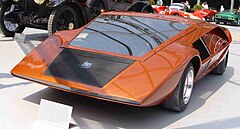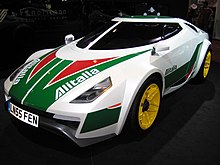Lancia Stratos HF
The Lancia Stratos HF is an automobile made by the Italian manufacturer Lancia . It was the first vehicle designed exclusively for rally use and was extremely successful in this motorsport . Among other things, Lancia won the World Rally Championships in 1974 , 1975 and 1976 with the Stratos , which at that time were only used as a rating for designers.
From study to series
In 1970 Bertone presented the design study Lancia Stratos 0 at the Turin Motor Show with the four-cylinder engine of the Lancia Fulvia as a mid-engine in front of the rear axle. It is not obvious to associate the concept of this design with rallies. The driver is placed extremely far forward so that his knees are between the front wheels. The opening windshield is the only door.
In 1971 the Lancia Stratos HF was presented with the six-cylinder engine of the Dino 246 GT . In contrast to the Stratos 0 , the motor is not installed lengthways but, as in the Dino, across the direction of travel. With a wheelbase of 2160 mm, length of 3670 mm, width of 1700 mm and height of 1080 mm, the car is very compact. The driver doesn't sit as far forward as in the Stratos 0 , but the footwell is extremely tight. To make repairs easier, the entire front section can be opened to the front and the entire rear section to the rear. Both parts are made of fiberglass-reinforced plastic , while the rest of the body is made of steel.
In the street version Stradale , the V6 engine has a displacement of 2.4 l, two-valve cylinder heads and a maximum output of 195 hp (143 kW ). From a standstill, the car reaches the 100 km / h mark in 6.8 s and a top speed of 248 km / h.
The Lancia Stratos HF was produced in a small series at Bertone in order to achieve its homologation in Group 4 of the FIA . In the end, 400 units were required for this, after the number of units originally required by the FIA had been reduced from 500 units. It is therefore unknown how many copies were actually made. Bertone himself estimates that there were around 495 pieces. At that time, the last new vehicles in Germany are said to have been sold for less than DM 15,000 . Nowadays you have to pay at least 300,000 euros for a good copy of this rare collector's item.
The then Lancia sports director Cesare Fiorio and factory rally driver Sandro Munari can be seen as the midwife of the Stratos - but the name of the British racing driver and engineer Mike Parkes behind the entire Lancia Stratos HF car sport project stands for the technology . The HF was chosen as the abbreviation for high fidelity . These two letters were adopted by the Lancia factory (according to a Lancia press release in 1971) with prior approval from the HF Squadra Corse , a club of Lancia racing drivers founded in 1963 , and used them several times later for particularly sporty models.
Racing history
In 1972 Lancia first used the Stratos in rallies, but was initially unable to compete with it. Mike Parkes joined Lancia in early 1974 and made a significant contribution to making the car competitive.
In the rally version ( group 4 ) and equipped with four-valve cylinder heads, the Stratos had around 280 hp (206 kW ). At the Giro automobilistico d'Italia - more of a race than a rally - Markku Alén is said to have driven a 420 hp (309 kW) Stratos to victory in 1978.
The only two Stratos manufactured by the factory for circuit racing according to the Group 5 regulations had a turbocharger and were therefore around 560 hp (412 kW). In 1976 and 1977 a Lancia Stratos team competed in the 24 Hours of Le Mans . In 1976 the Franco-Italian women's team Christine Dacremont and Lella Lombardi reached 20th place overall. A year later, after two hours of racing, engine failure stopped the ambitions of the French duo Christine Dacremont and Marianne Hoepfner .
In 1976 the Austrian Franz Wurz became European Rallycross Champion with a Lancia Stratos HF . For 1977 he received an engine from Mike Parkes which, thanks to a prototype crankshaft from the works team, had a displacement of almost three liters and a maximum output of a good 320 hp (235 kW). His compatriot and team-mate Andy Bentza took over this car at the end of 1977, with it became European Rallycross Champion in the newly created GT division in 1978, drove it in competitions well into the 1980s and had the only 3-liter Stratos until mid-2013 in his possession. After repeated inquiries from Franz Wurz, Bentza sold the car to his son Alexander , who had it completely renovated at a specialist workshop in Vienna and restored to its state of 1976, the year his father won his second European Championship. The former Formula 1 driver presented the completed Stratos to a wide audience at the Goodwood Festival of Speed 2016 .
In 1977 the Fiat group, to which Lancia already belonged, cut the racing budget of Lancia in favor of the works team with Fiat 131 Abarth . Lancia only took part in four rallies this year. After the sponsor Alitalia changed from Lancia to Fiat-Abarth in 1978, Lancia only competed in Europe. From 1979 the Stratos factory team no longer existed.
In 1979 a Stratos used by the French Lancia importer Chardonnet under Bernard Darniche / Alain Mahé won the Monte Carlo Rally for the last time.
Group 5 Lancia Stratos HF Turbo

New editions
Fenomenon Stratos
In spring 2005 the design studio Fenomenon Ltd. from London, whose owners include Stratos collector Christian Hrabalek, presented a study inspired by the Lancia Stratos at the Geneva Motor Show . Fenomenon called her first Stratos , later NewStratos . The vehicle was designed for wealthy customers in developing countries, who should enable them to drive a supercar on dirt roads. No investors were found to finance the announced series production.
New Stratos
After no new edition of the Stratos was planned by Lancia, the entrepreneur Michael Stoschek commissioned a New Stratos based on Ferrari from Pininfarina in autumn 2008 . The production model was presented at the 88th Geneva Motor Show in March 2018.
Web links
- stratossupersite.com (English)
Individual evidence
- ↑ a b BERTONE: historical collection. (No longer available online.) Archived from the original on February 22, 2011 ; accessed on September 16, 2010 (English).
- ↑ stratossupersite.com: Lancia Stratos - History. Retrieved September 16, 2010 .
- ^ Michael Johnson Parkes website: Filipinetti and Lancia. (No longer available online.) Formerly in the original ; Retrieved September 17, 2010 . ( Page no longer available , search in web archives )
- ↑ Classic Driver.com: Fenomenon Stratos. Retrieved September 16, 2010 .
- ^ Car Design News: First Sight - Fenomenon Stratos. (No longer available online.) Archived from the original on October 16, 2010 ; accessed on September 17, 2010 (English).
| Timeline of Lancia and Autobianchi models since 1945 | ||||||||||||||||||||||||||||||||||||||||||||||||||||||||||||||||||||||||||||
|---|---|---|---|---|---|---|---|---|---|---|---|---|---|---|---|---|---|---|---|---|---|---|---|---|---|---|---|---|---|---|---|---|---|---|---|---|---|---|---|---|---|---|---|---|---|---|---|---|---|---|---|---|---|---|---|---|---|---|---|---|---|---|---|---|---|---|---|---|---|---|---|---|---|---|---|---|
| Type | Lancia, independent until 1969 | Purchased by Fiat in 1969, Fiat number range since then | ||||||||||||||||||||||||||||||||||||||||||||||||||||||||||||||||||||||||||
| Autobianchi, JV between Bianchi, Fiat and Pirelli | from 1967 100% part of the Fiat group | abroad as Lancia, in Italy as Autobianchi | ||||||||||||||||||||||||||||||||||||||||||||||||||||||||||||||||||||||||||
| 1940s | 1950s | 1960s | 1970s | 1980s | 1990s | 2000s | 2010s | 2020s | ||||||||||||||||||||||||||||||||||||||||||||||||||||||||||||||||||||
| 5 | 6th | 7th | 8th | 9 | 0 | 1 | 2 | 3 | 4th | 5 | 6th | 7th | 8th | 9 | 0 | 1 | 2 | 3 | 4th | 5 | 6th | 7th | 8th | 9 | 0 | 1 | 2 | 3 | 4th | 5 | 6th | 7th | 8th | 9 | 0 | 1 | 2 | 3 | 4th | 5 | 6th | 7th | 8th | 9 | 0 | 1 | 2 | 3 | 4th | 5 | 6th | 7th | 8th | 9 | 0 | 1 | 2 | 3 | 4th | 5 | 6th | 7th | 8th | 9 | 0 | 1 | 2 | 3 | 4th | 5 | 6th | 7th | 8th | 9 | 0 | |
| Microcar | Bianchina | Giardiniera | ||||||||||||||||||||||||||||||||||||||||||||||||||||||||||||||||||||||||||
| Small car | A112 | Y10 (156) | Y (840) | Ypsilon (843) | Ypsilon (846) | |||||||||||||||||||||||||||||||||||||||||||||||||||||||||||||||||||||||
| Compact class | A111 | Delta I [2] (831) | Delta II (836) | Delta III (844) | ||||||||||||||||||||||||||||||||||||||||||||||||||||||||||||||||||||||||
| Middle class | Primula | Prism (831) | Dedra (835) | Lybra (839) | ||||||||||||||||||||||||||||||||||||||||||||||||||||||||||||||||||||||||
| ... Ardea | Appia | Fulvia | Beta / Trevi (828) | Flavia | ||||||||||||||||||||||||||||||||||||||||||||||||||||||||||||||||||||||||
| upper middle class | Flavia | 2000 | Gamma (830) | Theme (834 / Y9) | Kappa (838) | Thesis (841) | theme | |||||||||||||||||||||||||||||||||||||||||||||||||||||||||||||||||||||
| Coupé / convertible | Stellina | |||||||||||||||||||||||||||||||||||||||||||||||||||||||||||||||||||||||||||
| Fulvia Coupé / Sport | Beta Coupé [1] / Spider / Montecarlo (828) | |||||||||||||||||||||||||||||||||||||||||||||||||||||||||||||||||||||||||||
| Aurelia | Flaminia | Gamma Coupé / GT (830) |
Kappa Coupé (838) |
|||||||||||||||||||||||||||||||||||||||||||||||||||||||||||||||||||||||||
| Sports car | Stratos | |||||||||||||||||||||||||||||||||||||||||||||||||||||||||||||||||||||||||||
| Minivan | Musa (350) | |||||||||||||||||||||||||||||||||||||||||||||||||||||||||||||||||||||||||||
| Van | Zeta (220) | Phedra (179) | Voyager | |||||||||||||||||||||||||||||||||||||||||||||||||||||||||||||||||||||||||
|
[1] also built by Seat in Spain |
||||||||||||||||||||||||||||||||||||||||||||||||||||||||||||||||||||||||||||











